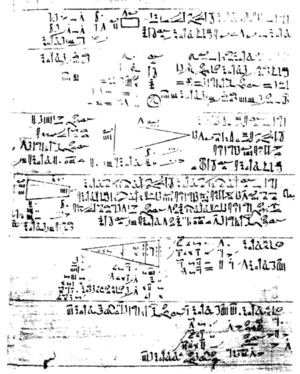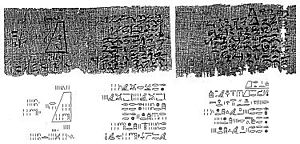Egyptian Mathematics: Geometric information from the papyri
The Rhind Mathematical Papyrus
This papyrus is sometimes called the Ahmes papyrys. Written by a scribe named Ahmes (Ahmose) in ca. 1550 BCE and bought in modern times by Charles Henry Rhind. The papyrus lists many problems covering topics in algebra, geometry and other areas in mathematics.
Problems from the Ahmes (or Rhind) Papyrus

Some of the following examples of the problems presented come from [Egyptian Mathematics] a website by G. Donald Allen, Professor at Texas A&M University, College Station. Others come from Corinna Rossi's book [1] and an article by R.C. Archibald [2].
In the Rhind papyrus there are nineteen problems of a geometric nature: nos. 41-46 and 48-60. The first six problems show how to calculate volume. The problems include finding volumes of right circular cylinders (granaries) and finding volumes and dimensions of paralellopipedal granaries.
Several problems from nos. 48-60 show how to compute area. Formulas are given for the area of a triangle and several four sided figures. The remaining problems "deal with the relation of the lengths of two sides of a right triangle which corresponds to the cotangent of e angle which a face of a regular pyramid makes with its base. This is called the seked of the pyramid." [2]
Definition: The unknown, x , is called the heep.
Problem 24. Find the heep if the heep and a seventh of the heep is 19.
Problems 44-46 Discuss the volumes and dimensions of Parallelopipedal granaries.[2]
Problem 48 This problem shows how the formula from problem 50 is arrived at.
Trisect each side. Remove the corner triangles. The resulting octagonal Þgure approximates the circle. The area of the octagonal figure is:
approximate 63 to be 64 and note that
Thus the number plays the role of π. That this octagonal figure, whose area is easily calculated, so accurately approximates the area of the circle is just plain good luck. Obtaining a better approximation to the area using finer divisions of a square and a similar argument is not simple. <ref>Don Allen http://www.math.tamu.edu/~dallen/masters/egypt_babylon/egypt.pdf [[1] PDF file]Cite error: The opening <ref> tag is malformed or has a bad name
Problem 50. A circular field of diameter 9 has the same area as a square of side 8.
Problem 51 Find the area of a triangle given its base and altitude.[2]
Problem 52 Find the area of a trapezium with (apparently) eqully slanting sides. The lengths of the parallel sides and the distance between them being the given numbers.[2]
Problem 56 This problem indicates an understanding of the idea of geometric similarity. This problem discusses the ratio The problem essentially asks to compute the cotangent for some angle . Such a formula would be need for building pyramids.
Problem 57. The height of a pyramid is calculated from the base length and the seked (egyptian for slope).
Problems 58, 59 and 60. These problems, together with 56 and 57, contain calculations involving the seked of pyramids.
Problem 63. 700 loaves are to be divided among recipients where the amounts they are to receive are in the continued proportion
Definition: The strength is given by the following formula
Problem 72. How many loaves of strength 45 are equivalent to 100 loaves of strength 10?
Problem 79. This problem cites only ``seven houses, 49 cats, 343 mice, 2401 ears of spelt, 16,807 hekats."
The Moscow Papyrus

The Moscow Mathematical Papyrus is also called the Golenischev Mathematical Papyrus, after its first owner, Egyptologist Vladimir Goleniščev. The Papyrus dates to the Middle Kingdom, ca. 1700 BCE. The Moscow papyrus is smaller than the Rhind papyrus. The most often quoted problem is problem 14. In this problem the volume of a truncated pyramid is computed.
Problems form the Moscow Papyrus
Problem 4. Identical to problem 51 of the Rhind Mathematical Papyrus. [2]
Problem 6. Given a rectangular enclosure of 12 units area and the ratio of the sides as 1 : 3/4, find the lengths of the sides. This problem seems to be identical to one of the Kahun Papyri in London.
The steps of the solution given in both papyri is the same:
Problem 7. "A triangle of given area is such that it altitude is 2.5 times its base; find both."[2]
Problem 10. Computes the area of a hemisphere. [2]
Problem 14. The base is a square of side 4 cubits, the top is a square of side 2 cubits and the height of the truncated pyramid is 6 cubits.
The text reads: " Example of calculating a truncated pyramid. If you are told: a truncated pyramid of 6 for the vertical height by 4 on the base by 2 on top:
You are to square this 4; result 16. You are to double 4; result 8. You are to square this 2; result 4. You are to add the 16 and the 8 an the 4; result 28. You are to take 1/3 of 6; result 2. You are to take 28 twice; result 56. See it is of 56. You will find (it) right." [2]
Other Mathematical sources
- Berlin Papyrus
- Egyptian Mathematical Leather Roll
- Kahun Papyri






